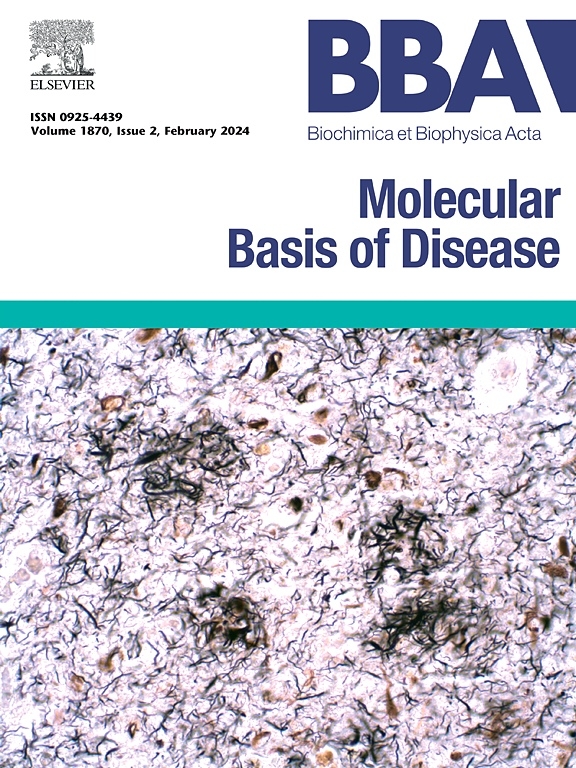揭示QRICH1调节对外源性脑损伤内质网应激和神经元凋亡的影响。
IF 4.2
2区 生物学
Q2 BIOCHEMISTRY & MOLECULAR BIOLOGY
Biochimica et biophysica acta. Molecular basis of disease
Pub Date : 2024-12-09
DOI:10.1016/j.bbadis.2024.167621
引用次数: 0
摘要
背景:外伤性脑损伤(TBI)是一个发病率和死亡率高的主要公共卫生问题。继发性脑损伤以炎症反应和细胞凋亡为特征,使TBI预后恶化。内质网应激(ERS)反应与继发性脑损伤有关,谷氨酰胺富1基因(QRICH1)成为潜在的中介。然而,QRICH1在TBI发病机制中的确切作用及其治疗意义尚不清楚。方法:采用控制性皮质冲击小鼠模型和脂多糖刺激原代神经元模型。行为评估,包括改良加西亚评分、y迷宫测试和开放场测试,用于评估小鼠术后恢复情况。QRICH1神经元条件敲除(cKO)小鼠用于评估QRICH1功能,而腺相关病毒(AAV)介导的基因操作用于调节皮质神经元中QRICH1的表达。结果:western blot和免疫荧光染色结果显示,TBI小鼠脑组织中QRICH1表达上调,尤其是损伤后24 h。QRICH1定位于神经元核内,提示其在细胞应激反应中起作用。QRICH1 cKO改善了tbi后的行为结果,而aav介导的QRICH1过表达加重了继发性脑损伤,其特征是ers相关蛋白表达增加和神经元死亡。相反,aav介导的QRICH1敲低可以减少继发性脑损伤,这可以通过降低ers相关蛋白表达和神经元死亡来证明。结论:QRICH1在继发性脑损伤中加重ERS和细胞凋亡,影响神经元命运中起关键作用。QRICH1参与脑外伤后ERS通路和神经元凋亡的诱导,使其成为脑外伤治疗的潜在治疗靶点。本文章由计算机程序翻译,如有差异,请以英文原文为准。

Unravelling the impact of QRICH1 modulation on endoplasmic reticulum stress and neuronal apoptosis in traumatic brain injury
Background
Traumatic brain injury (TBI) is a major public health concern with high morbidity and mortality rates. Secondary brain injury, marked by inflammatory responses and apoptosis, worsens TBI outcomes. The endoplasmic reticulum stress (ERS) response has been implicated in secondary brain injury, with Glutamine Rich 1 Gene (QRICH1) emerging as a potential mediator. However, the precise role of QRICH1 in TBI pathogenesis and its therapeutic implications remain unclear.
Methods
Controlled cortical impact mouse and Lipopolysaccharide-stimulated primary neuron models were used. Behavioral assessments, including the modified Garcia score, Y-maze test, and open-field test, were used to evaluate postoperative recovery in mice. QRICH1 neuron conditional knockout (cKO) mice were used to assess QRICH1 function, whereas adeno-associated virus (AAV)-mediated gene manipulation was used to modulate QRICH1 expression in cortical neurons.
Results
QRICH1 expression was upregulated in the brain tissue of TBI mice, particularly 24 h post-injury, as shown by western blot analysis and immunofluorescence staining. QRICH1 is localized within neuronal nuclei, suggesting a role in cellular stress responses. QRICH1 cKO improved behavioral outcomes post-TBI, whereas AAV-mediated QRICH1 overexpression exacerbated secondary brain injury, characterized by increased ERS-related protein expression and neuronal death. Conversely, AAV-mediated QRICH1 knockdown reduced secondary brain injury as evidenced by decreased ERS-related protein expression and neuronal death.
Conclusion
QRICH1 plays a critical role in exacerbating ERS and apoptosis, and influences neuronal fate in secondary brain injury. Its involvement in the ERS pathway and in the induction of neuronal apoptosis post-TBI highlights QRICH1 as a potential therapeutic target for TBI treatment.
求助全文
通过发布文献求助,成功后即可免费获取论文全文。
去求助
来源期刊
CiteScore
12.30
自引率
0.00%
发文量
218
审稿时长
32 days
期刊介绍:
BBA Molecular Basis of Disease addresses the biochemistry and molecular genetics of disease processes and models of human disease. This journal covers aspects of aging, cancer, metabolic-, neurological-, and immunological-based disease. Manuscripts focused on using animal models to elucidate biochemical and mechanistic insight in each of these conditions, are particularly encouraged. Manuscripts should emphasize the underlying mechanisms of disease pathways and provide novel contributions to the understanding and/or treatment of these disorders. Highly descriptive and method development submissions may be declined without full review. The submission of uninvited reviews to BBA - Molecular Basis of Disease is strongly discouraged, and any such uninvited review should be accompanied by a coverletter outlining the compelling reasons why the review should be considered.

 求助内容:
求助内容: 应助结果提醒方式:
应助结果提醒方式:


